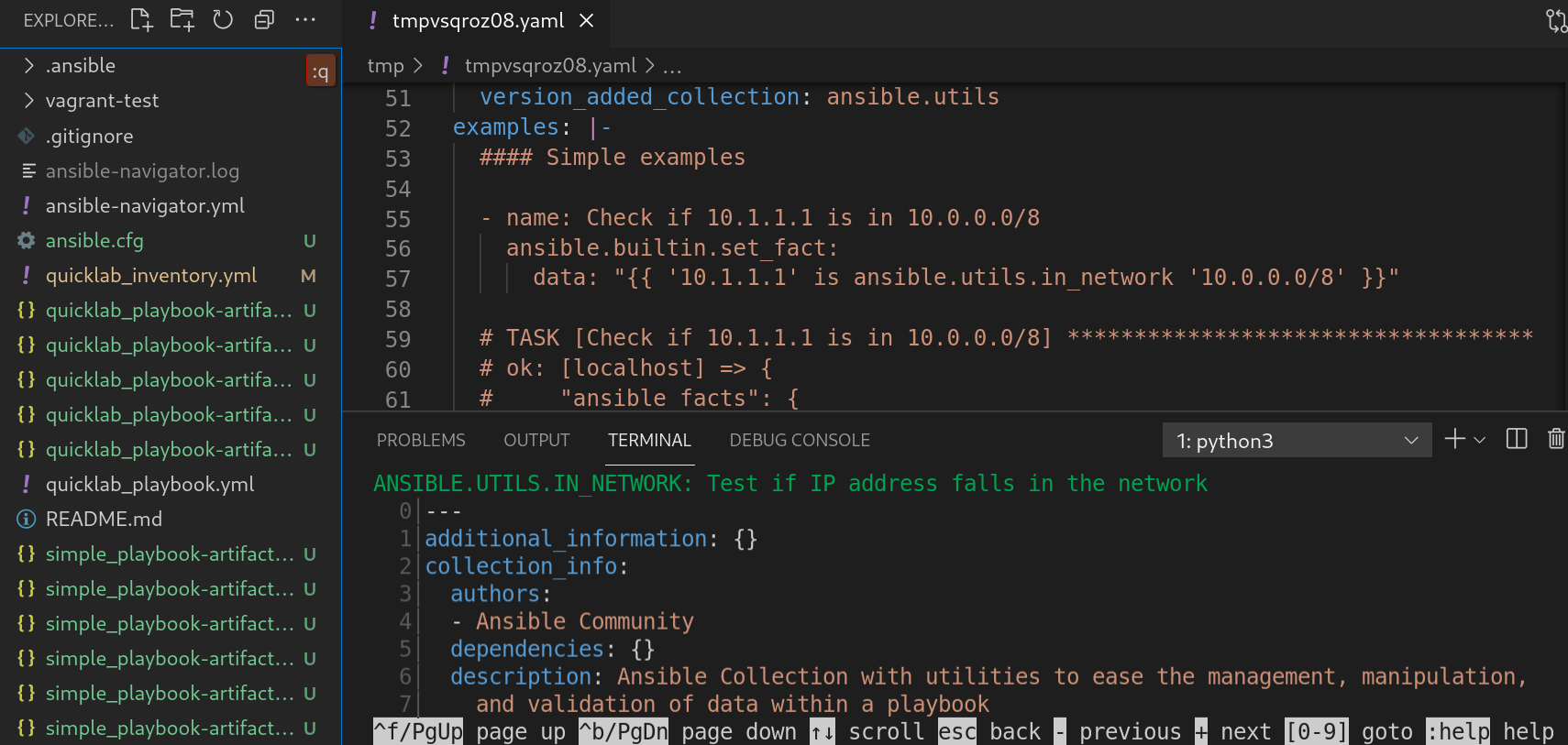Chapter 5. Browsing collections with Automation content navigator
As a content creator, you can browse your Ansible collections with Automation content navigator and interactively delve into each collection developed locally or within Automation execution environments.
5.1. Automation content navigator collections display
Automation content navigator displays information about your collections with the following details for each collection:
- SHADOWED
- Indicates that an additional copy of the collection is higher in the search order, and playbooks prefer that collection.
- TYPE
-
Shows if the collection is contained within an automation execution environment or volume mounted on onto the automation execution environment as a
bind_mount. - PATH
- Reflects the collections location within the automation execution environment or local file system based on the collection TYPE field.

5.2. Browsing collections from Automation content navigator
You can browse Ansible collections with the Automation content navigator text-based user interface in interactive mode and delve into each collection. Automation content navigator shows collections within the current project directory and those available in the automation execution environments
Prerequisites
- A locally accessible collection or installed automation execution environments.
Procedure
Start Automation content navigator
$ ansible-navigator
Browse the collection. Alternately, you can type
ansible-navigator collectionsto directly browse the collections.$ :collections

Type the number of the collection you want to explore.
:4

Type the number corresponding to the module you want to delve into.
ANSIBLE.UTILS.IP_ADDRESS: Test if something in an IP address 0│--- 1│additional_information: {} 2│collection_info: 3│ authors: 4│ - Ansible Community 5│ dependencies: {} 6│ description: Ansible Collection with utilities to ease the management, manipulation, 7│ and validation of data within a playbook 8│ documentation: null 9│ homepage: null 10│ issues: null 11│ license: [] 12│ license_file: LICENSE 13│ name: ansible.utils 14│ namespace: ansible 15│ path:/usr/share/ansible/collections/ansible_collections/ansible/utils/ 16│ readme: README.md <... output truncated...>Optional: jump to the documentation examples for this module.
:{{ examples }} 0│ 1│ 2│#### Simple examples 3│ 4│- name: Check if 10.1.1.1 is a valid IP address 5│ ansible.builtin.set_fact: 6│ data: "{{ '10.1.1.1' is ansible.utils.ip_address }}" 7│ 8│# TASK [Check if 10.1.1.1 is a valid IP address] ********************* 9│# ok: [localhost] => { 10│# "ansible_facts": { 11│# "data": true 12│# }, 13│# "changed": false 14│# } 15│Optional: open the example in your editor to copy it into a playbook.
:open

Verification
Browse the collection list.

Additional resources
5.3. Review documentation from Automation content navigator
You can review Ansible documentation for collections and plugins with the Automation content navigator text-based user interface in interactive mode. Automation content navigator shows collections within the current project directory and those available in the automation execution environments
Prerequisites
- A locally accessible collection or installed automation execution environments.
Procedure
Start Automation content navigator
$ ansible-navigator
Review the module you are interested in. Alternately, you can type
ansible-navigator docto access the documentation.:doc ansible.utils.ip_address
ANSIBLE.UTILS.IP_ADDRESS: Test if something in an IP address 0│--- 1│additional_information: {} 2│collection_info: 3│ authors: 4│ - Ansible Community 5│ dependencies: {} 6│ description: Ansible Collection with utilities to ease the management, manipulation, 7│ and validation of data within a playbook 8│ documentation: null 9│ homepage: null 10│ issues: null 11│ license: [] 12│ license_file: LICENSE 13│ name: ansible.utils 14│ namespace: ansible 15│ path:/usr/share/ansible/collections/ansible_collections/ansible/utils/ 16│ readme: README.md <... output truncated...>Jump to the documentation examples for this module.
:{{ examples }} 0│ 1│ 2│#### Simple examples 3│ 4│- name: Check if 10.1.1.1 is a valid IP address 5│ ansible.builtin.set_fact: 6│ data: "{{ '10.1.1.1' is ansible.utils.ip_address }}" 7│ 8│# TASK [Check if 10.1.1.1 is a valid IP address] ********************* 9│# ok: [localhost] => { 10│# "ansible_facts": { 11│# "data": true 12│# }, 13│# "changed": false 14│# } 15│Optional: open the example in your editor to copy it into a playbook.
:open

See Automation content navigator general settings for details on how to set up your editor.
Additional resources